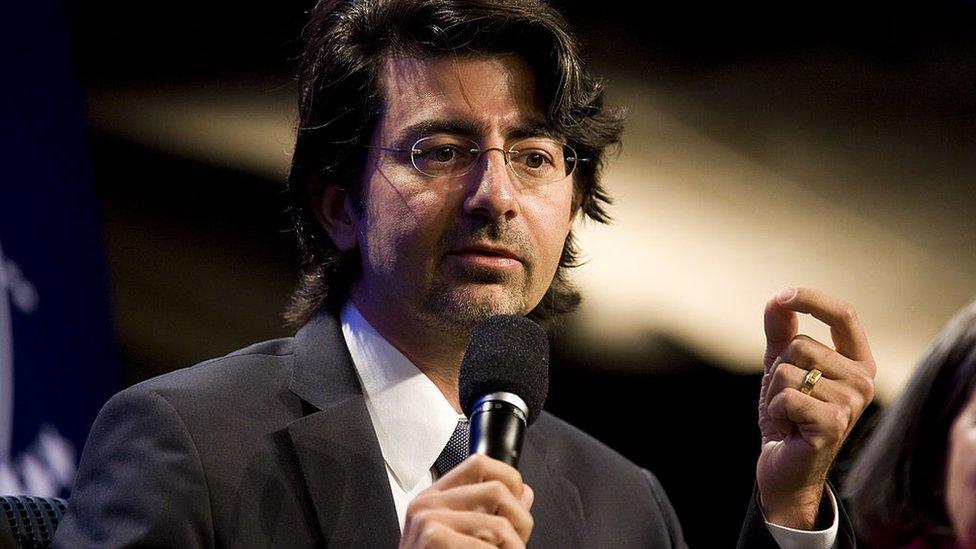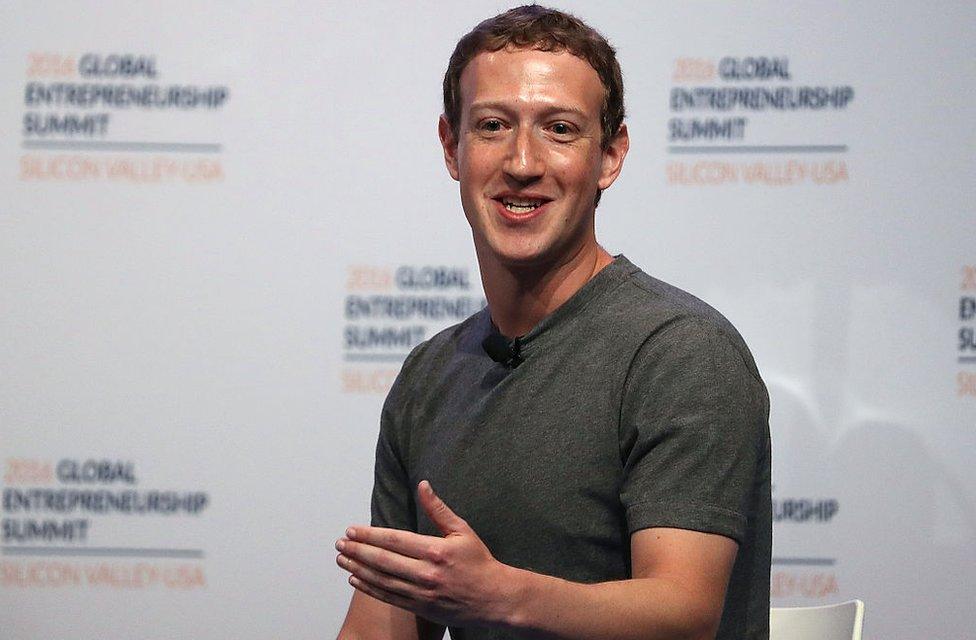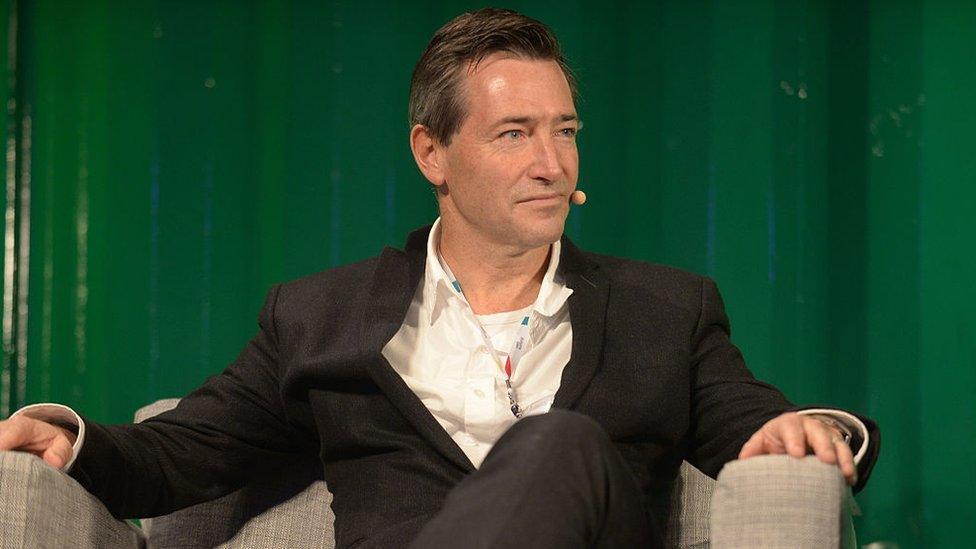Two visions for the future of media
- Published
A multi-billionaire donates $100m to investigative journalism and hacks everywhere ask "where do I apply?".
Is this what the future of media looks like?
I hope not. As modern entrepreneurs go, Pierre Omidyar is among the most innovative and successful. With a net worth, according to Forbes, external, of just over $8bn (£6.3bn), the founder of eBay and First Look Media has used his Omidyar Network to plough huge sums into philanthropy. At the Skoll World Forum in Oxford this week, he said his latest pledge would be distributed over three years, with the aim of fighting the "root causes of the global trust deficit".

Ebay founder Pierre Omidyar donating to fight the "root causes of the global trust deficit"
He went on: "A free and independent media is key to providing trusted information and critical checks and balances on those in positions of power".
The first $4.5m (£3.6m) will go to the International Consortium of Investigative Journalists (ICIJ), which produced the revelatory Panama Papers in 2016.
The new industrialists
This is hugely admirable. I wish I had made $8bn, so that I could put one pound in every 80 of my fortune toward uncovering great scoops. And, together with a couple of other developments this week, it shows who is making the running in modern news: Very rich tech industrialists.
On Monday, Facebook announced the launch of the News Integrity Initiative, external, a $14m project to improve news literacy around the world. This afternoon, Adam Mosseri, Facebook's Vice-President for News Feed, also announced the launch of a new educational tool to help users spot fake news.
And Full Fact, external, the British fact-checking organisation, is re-publishing its top tips for spotting fake news. These will appear in users' news feeds tomorrow and over the weekend.
All this follows a raft of measures in recent months to show that the social media giant - and specifically its founder, Mark Zuckerberg - take the spread of misinformation online very seriously.
But look more closely at that News Integrity Initiative: It's a collaboration with other international partners, including the Craig Newmark Philanthropic Fund, the Ford Foundation, John S and James L Knight Foundation, and Tow Foundation. That's a lot of charities right there.
In other words, the two biggest announcements in the world of media this week - involving the long-term funding of investigative journalism, and the attempt to protect citizens from the ill-effects of fake news - both stem from charity.

Facebook CEO Mark Zuckerberg: joining with other charities to improve news literacy around the world
Journalism has always depended on charity. In fact, it has always relied on the whims, fancies and vanity of rich men (it has tended to be men) in particular, who are prepared to lose huge sums of money in return for political and commercial influence. Sometimes they are prepared to lose huge sums of money because they believe deeply in the intrinsic value of journalism, but this is rare.
So, in a sense, the likes of Omidyar and Zuckerberg putting up cash to create a more informed citizenry is nothing new: They're just a digital update of the press barons of the past.
Except for the context, that is. Today, the business model for sustaining high-quality journalism has been undermined by the internet, which has turned general news into a widely available commodity. Consequently, there is a real danger that journalism becomes ever more dependent on charity, especially from the very rich.
But charity is a poor basis for high-quality journalism, because it cannot be relied upon. The whim of donors might be fragile; and excessive dependence on the favour of individuals can leave you exposed. One virtue of The Guardian's current business model, in which it asks digital readers for donations, is that it will help create a broad base of supporters who can be tapped up regularly. (Whether these contributions can meaningfully contribute to eradicating losses currently in the tens of millions of pounds is a more open question).
The news that Omidyar is giving so generously to support journalism is, then, both welcome and a warning. Welcome, because $100m going into scrutiny of the rich and powerful is a great service to democracy. But a warning, because Omidyar knows that his $100m is especially welcome specifically because conventional sources of funding for investigative journalism - that is, paying readers, viewers and listeners - are thought to be in short supply.
But are they?
In a February blog post, I argued that recent evidence suggests many readers are willing to pay for quality, as shown by the growing circulations of The Spectator, New Statesman, and Private Eye.
Fresh evidence arrived this week, in the shape of the Financial Times' annual results. Across digital and print, the pink'un has a circulation that's nudging 850,000, external. That's up eight per cent year on year. Digital subscriptions - that is, people paying for journalism online, across multiple platforms - accounts for 650,000 of the total: more than three quarters, and up 14 per cent year on year.
The FT has three big advantages over some of its rivals. First, it is both a specialist and general publication, because it has financial information that some companies prize. And, of course, one viable future for journalism is specialism: Just think of all those guest publications in the final round of Have I Got News For You.
Second, it has a clientele who are generally wealthier than those of, say, most tabloids. And third, a combination of these two factors mean many of their customers can get their companies to pay for those subscriptions.
Nevertheless, it has deployed these advantages effectively. You can't argue with the success of Chief Executive John Ridding's strategy of the "march to a million" - the aim to get to a million subscribers by 2020.

John Ridding, chief executive officer of the Financial Times, is on a "march to a million"
Years ago, I made - and comprehensively lost - an internal argument at The Independent that that paper (which I was not yet Editor of) should go radically upmarket, and become a kind of white FT that had the confidence to charge.
My thinking was that profit is the ultimate and best guarantee of independence; that if you're reliant on advertising alone, your ultimate fidelity is to advertisers rather than readers; and that being paid by your readers has the double advantage of reducing your exposure to the ad market and deepening your relationship with the audience.
A safer bet
There's not much I've seen in the past few years to persuade me that's wrong. We know that The Economist believes print display advertising will completely disappear, external in the next few years. Media organisations wholly or solely dependent on advertising will find they are susceptible to the vagaries of an ad market which is anyway being gobbled up by Facebook and Google; and their editorial values under pressure from the need to drive traffic.
Of course, you might argue all this is easy for me to say, writing as I am in the offices of a licence-fee funded public broadcaster. That's another model for funding journalism, the long-term viability of which is a subject for another day.
For students with ambitions to enter journalism, this week provided two visions of what the future of this trade looks like: Dependence on charity, and dependence on committed customers, also known as viable business.
For all that Omidyar's largesse is to be applauded, the latter is a much safer bet.
- Published15 March 2017
- Published25 February 2017
- Published20 March 2017